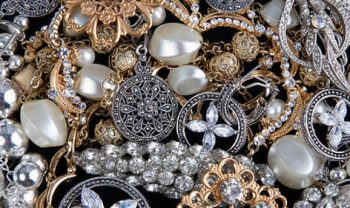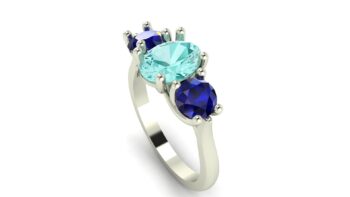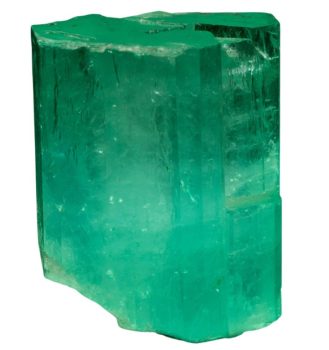Tanzanite is a stunning gemstone that makes beautiful jewelry. It is one of our favorite stones and we actually prefer it to sapphire in many instances. However, it is a relatively new gemstone. That, and the fact that the stone is only found in one place on earth and is believed to run out in around 30 years has made tanzanite a very popular stone. Well, those aren’t the only reasons. It is also a stone unlike most in the gemstone world with its eye visible pleochroism. That means it shows different colors when viewed from different angles. But we will get to that later. In this post, we will discuss tanzanite and why we love it for jewelry.
What Is A Tanzanite?
Tanzanite is a rare gemstone that was discovered in Tanzania in the 1960s. It is a blue-violet variety of the mineral zoisite and is known for its vibrant color and high clarity. Tanzanite is valued for its rarity and unique color, which ranges from a deep blue to a violet-blue hue. It is often used in jewelry, particularly in rings, earrings, and pendants. Due to its limited supply and increasing demand, tanzanite has become a highly sought-after gemstone in the market. Whether you’re a gemstone enthusiast or simply looking for a stunning piece of jewelry, tanzanite is a captivating choice that is sure to leave a lasting impression.
One of the distinguishing features of tanzanite is its pleochroism, which means it can exhibit different colors when viewed from different angles. This characteristic adds to its allure and makes each tanzanite gemstone truly unique. The color of tanzanite is influenced by the presence of trace elements, such as vanadium, which gives it its blue and violet hues. The finest quality tanzanite is a vivid blue color with a hint of violet, often referred to as “electric” or “vivid” blue.
Tanzanite is also known for its remarkable clarity and transparency. High-quality tanzanite gemstones are typically free from visible inclusions. They also have a high level of transparency, allowing light to pass through and enhance their brilliance. The combination of its intense color and excellent clarity makes tanzanite a highly desirable gemstone for both collectors and jewelry enthusiasts.
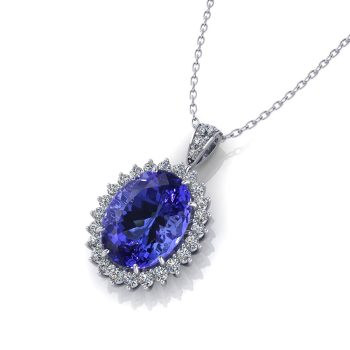
Tanzanite History & Mineral Composition
Tanzanite is a gemstone that holds a rich history and fascinating mineral composition. The discovery of tanzanite is a captivating tale. It was found in the foothills of Mount Kilimanjaro by a local Maasai tribesman named Ali Juuyawatu. Initially mistaken for sapphires due to their similar blue color, tanzanite was later identified as a new gemstone variety. The gemstone was named after its country of origin, Tanzania, and quickly gained international recognition for its exceptional beauty.
Tanzanite’s mineral composition is what sets it apart from other gemstones. It belongs to the epidote mineral group and is primarily composed of calcium aluminum silicate. The presence of vanadium is what gives tanzanite its distinctive blue color, ranging from a deep blue to a violet-blue hue. Tanzanite is also pleochroic, meaning it can exhibit different colors when viewed from different angles. This unique characteristic adds to its allure and makes it a highly sought-after gemstone.
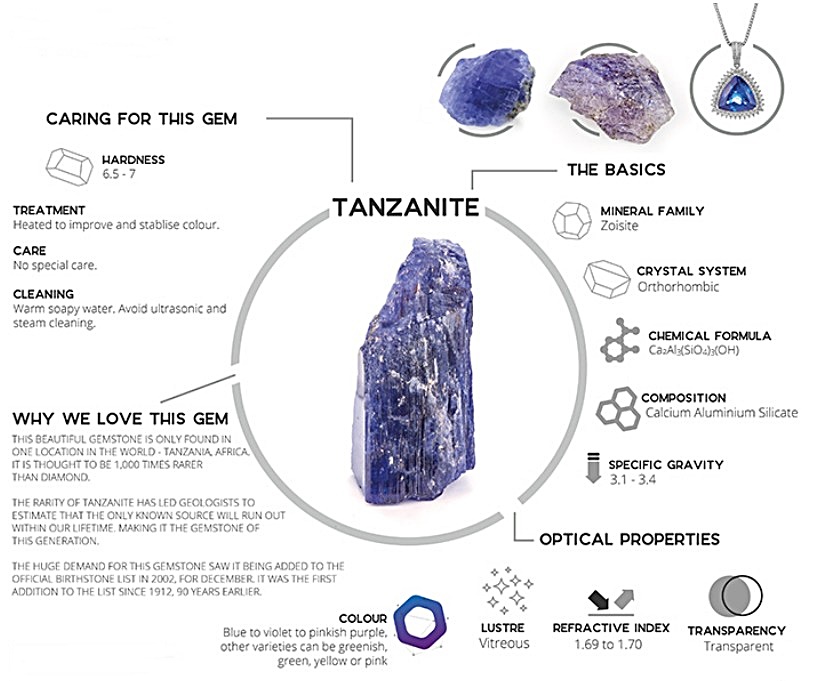
Tanzanite Color
Tanzanite is a gemstone known for its stunning range of colors. From deep blue to violet and even hints of purple, tanzanite offers a wide spectrum of hues. This gemstone’s color range is truly mesmerizing and makes it a popular choice for jewelry. Whether you prefer a vibrant blue tanzanite or a more subtle violet shade, there is a color to suit every taste and style.
The color of tanzanite can vary depending on factors such as the lighting conditions and the angle at which it is viewed. In natural daylight, tanzanite tends to display a rich blue color with violet undertones. However, under incandescent lighting, it can appear more violet or even purple. This chameleon-like quality is what makes tanzanite so unique and captivating.
When choosing a tanzanite, it is important to consider your personal preferences and the desired effect you want to achieve. Some people are drawn to the intense blue hues of tanzanite, while others prefer the softer, more romantic violet shades. Whichever color you choose, tanzanite is sure to add a touch of elegance and sophistication to any piece of jewelry. So, whether you opt for a deep blue tanzanite pendant or a delicate violet tanzanite ring, you can be confident that you are wearing a gemstone with a truly breathtaking color range.
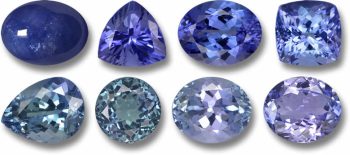
Tanzanite Pleochroism
Tanzanite is a gemstone known for its unique pleochroism. Pleochroism refers to the phenomenon where a mineral exhibits different colors when viewed from different angles. In the case of tanzanite, it is trichroic. It can display blue, violet, and burgundy or green hues depending on the direction of light. This optical property adds to the allure and beauty of tanzanite, making it a highly sought-after gemstone in the jewelry industry.
The pleochroism of tanzanite is due to its crystal structure and composition. Tanzanite is a variety of the mineral zoisite, which is composed of calcium aluminum silicate. The presence of trace amounts of vanadium in tanzanite is responsible for its blue and violet colors. When light enters the crystal, it is absorbed by the vanadium ions, causing the gemstone to appear blue or violet. The burgundy color is a result of the absorption of yellow light by manganese ions in the crystal.
Tanzanite’s pleochroism can be observed by rotating the gemstone and observing the changes in color. This optical property makes tanzanite a versatile gemstone, as it can be cut and set in different angles to showcase its various colors. Whether it is set in a ring, pendant, or earrings, tanzanite’s pleochroism adds a captivating element to any piece of jewelry.
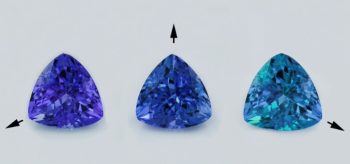
Why Tanzanite Jewelry Is So Hot
Tanzanite jewelry is popular for several reasons. Firstly, tanzanite is a stunning gemstone known for its vibrant blue-violet color, which is highly sought after by jewelry enthusiasts. The gemstone’s unique color is often compared to sapphire and amethyst, making it a desirable choice for those looking for a distinctive piece of jewelry.
Additionally, tanzanite is relatively rare, as it can only be found in one location in the world – Tanzania. This exclusivity adds to its allure and increases its value in the market. Lastly, tanzanite is believed to possess metaphysical properties, such as promoting spiritual growth and enhancing intuition, which further contributes to its popularity among those who value both aesthetics and symbolism in their jewelry choices. In conclusion, the combination of tanzanite’s mesmerizing color, rarity, and perceived metaphysical properties make it a highly popular choice for jewelry lovers worldwide.
Types Of Jewelry Tanzanite Works Well In
Tanzanite is a versatile choice for jewelry. Its unique color and brilliance make it suitable for a variety of styles and occasions. Whether you’re looking for a statement piece or a subtle accent, here are some types of jewelry that tanzanite works well in.
Firstly, tanzanite is often used in rings. Its vibrant blue hue adds a touch of elegance and sophistication to any ring design. Whether set in platinum, white gold, or yellow gold, tanzanite rings are sure to catch the eye. From solitaire rings to intricate halo designs, there are endless options to choose from.
Secondly, tanzanite is a popular choice for earrings. Its rich blue color adds a pop of color to any outfit, making it a versatile accessory. Whether you prefer studs, hoops, or drop earrings, tanzanite can be incorporated beautifully. Pair them with a matching tanzanite necklace for a coordinated look.
Lastly, tanzanite is often used in pendants and necklaces. The deep blue color of tanzanite makes it a striking centerpiece for a pendant. Whether it’s a simple solitaire pendant or a more elaborate design, tanzanite adds a touch of glamour to any necklace. Pair it with a delicate chain for a dainty look or a chunky chain for a bold statement.
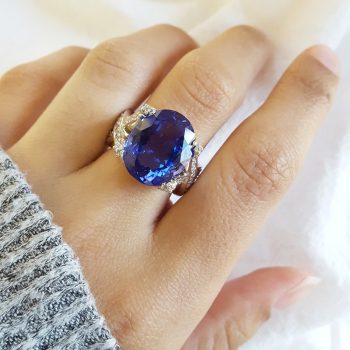
Tanzanite Healing Properties
Tanzanite is believed to have various healing properties that can benefit both the mind and body. One of the main properties of tanzanite is its ability to promote spiritual growth and awareness. It is said to enhance intuition and help individuals connect with their higher selves. Additionally, tanzanite is believed to have a calming effect on the mind, helping to reduce stress and anxiety. It is also thought to aid in communication and self-expression, making it a popular choice for those who wish to improve their public speaking skills. Overall, tanzanite is a gemstone that not only adds beauty to jewelry, but also offers potential healing benefits to those who wear it.
Cons Of Tanzanite
Tanzanite, while a beautiful gemstone, does have its drawbacks. One of the main cons of Tanzanite is its relatively low durability. It ranks at 6.5 to 7 on the Mohs scale of hardness, making it more prone to scratches and damage compared to other gemstones like diamonds or sapphires. Additionally, Tanzanite is also sensitive to heat and sudden temperature changes, which can cause it to crack or break.
Another con of Tanzanite is its limited availability. This gemstone is found exclusively in Tanzania, specifically in the Merelani Hills near Mount Kilimanjaro. This limited source makes Tanzanite relatively rare and increases its price. It can be challenging to find high-quality Tanzanite in larger sizes, and this scarcity can make it less accessible to some consumers.
Lastly, Tanzanite’s color can also be a disadvantage for some individuals. While many people appreciate its unique blue-violet hue, others may prefer more traditional gemstone colors like blue or green. The distinct color of Tanzanite may not appeal to everyone’s taste, limiting its desirability in certain markets.
Tanzanite Cost
Tanzanite can vary significantly in cost depending on various factors. The most important factors that influence the price of tanzanite include the gemstone’s size, color, clarity, and overall quality. Generally, larger tanzanite gemstones with intense blue or violet hues and excellent clarity command higher prices. The lower end is more of a lavender color and will usually have eye visible inclusions. On average, tanzanite can range anywhere from $200 to $2000 per carat. However, it’s important to note that prices can go much higher for exceptional tanzanite specimens. Some stones can even approach the cost of high quality sapphire.
Is Tanzanite A Good Investment?
While we are not of the opinion that gemstones make good investments, that doesn’t stop people from using them as such. And with careful purchasing, they can become more valuable over time. While we don’t espouse it, here are a few key points to consider when evaluating Tanzanite as an investment.
Firstly, Tanzanite’s scarcity is a significant factor in its investment potential. The gemstone is only found in a small area near Mount Kilimanjaro and is estimated to be 1,000 times rarer than diamonds. As a result, the supply of Tanzanite is limited, which can drive up its value over time.
Secondly, Tanzanite’s value has shown a steady increase over the years. Since its discovery in the 1960s, Tanzanite has consistently appreciated in value, making it an appealing investment option. However, it’s important to note that like any investment, the value of Tanzanite can fluctuate, and there are no guarantees of high returns.
Lastly, the demand for Tanzanite continues to grow, particularly in the luxury jewelry market. Its vibrant color and unique properties make it a sought-after gemstone for collectors and enthusiasts. This increasing demand, coupled with limited supply, further adds to its investment potential.

Tanzanite Care And Maintenance
Tanzanite is a beautiful gemstone that requires proper care and maintenance to ensure its longevity and brilliance. To keep your Tanzanite looking its best, it is important to follow a few simple guidelines.
Firstly, Tanzanite should be stored separately from other gemstones and jewelry to prevent scratching. It is recommended to keep it in a soft cloth or a jewelry box with individual compartments. Avoid storing Tanzanite in direct sunlight or extreme temperatures, as this can cause color fading or damage.
Secondly, cleaning Tanzanite is easy but requires gentle handling. Use warm soapy water and a soft brush to clean the gemstone. Avoid using harsh chemicals or ultrasonic cleaners, as they can damage the stone. After cleaning, rinse the Tanzanite thoroughly and pat it dry with a soft cloth.
Lastly, Tanzanite should be worn with care to prevent accidental damage. Avoid wearing Tanzanite while engaging in activities such as sports, gardening, or household chores. It is also advisable to remove Tanzanite jewelry before applying lotions, perfumes, or hairspray, as these substances can dull the gemstone’s shine.
By following these simple care and maintenance tips, you can ensure that your Tanzanite remains beautiful and radiant for years to come. Remember to handle it with care, store it properly, and clean it gently. With proper care, your Tanzanite will continue to be a stunning addition to your jewelry collection.
How Not To Get Ripped Off When Buying Tanzanite
Luckily, there is no lab tanzanite. Yet. They have tried, but tanzanite has never been successfully synthesized in a lab. That is good for consumers as buying lab as natural is the easiest way to be ripped off. However, that doesn’t mean there are other ways you can be swindled. There are a few man made stones that can be sold as natural tanzanite. CZ, ytrium aluminum garnet (YAG), and synthetic spinel can all pass as tanzanite
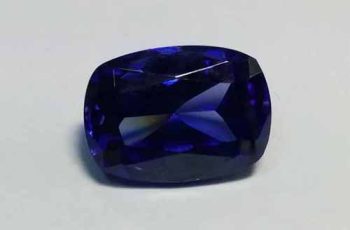
This is a purple CZ that looks very much like mid-grade tanzaniteLuckily, all of those stones are singly refractive while tanzanite is double refractive. That might sound complicated, but it isn’t with the use of a cheap tool called a dichroscope.
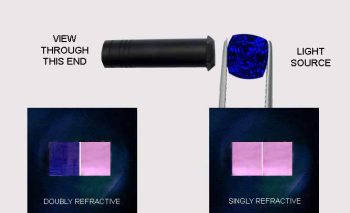
When you look at tanzanite though a dicroscope, you will see two colors. Those imitations will all show one color.
Iolite
In the natural world, Iolite can be sold as tanzanite. Iolite and tanzanite are both beautiful gemstones, but they have distinct characteristics that set them apart.
Firstly, their color is a key factor in distinguishing between the two. Iolite typically exhibits a range of blue shades, from pale blue to deep blue, while tanzanite is known for its vibrant blue or violet-blue hue. Tanzanite will almost always have a violet or purple component.
Iolite and tanzanite are gemstones that exhibit pleochroism, although differently. In the case of iolite, also known as “water sapphire,” it typically appears violet-blue when viewed from one angle and yellow-gray from another. When tanzanite is viewed from different angles, it can exhibit shades of blue, violet, or even burgundy.
The pleochroism observed in iolite and tanzanite is a result of their crystal structures. These gemstones belong to the mineral group known as the silicates. The arrangement of atoms within their crystal lattice causes light to interact differently, resulting in the varying colors observed. By considering these factors – color, clarity, and origin – you can confidently tell the difference between iolite and tanzanite.
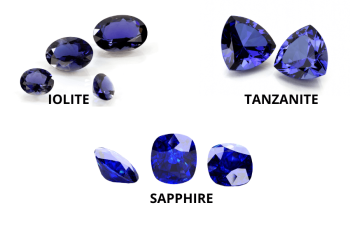
Looking For Tanzanite Jewelry? Give Us A Shot
We create custom jewelry from the ground up. This means you will be able to choose any tanzanite available for whatever it is you want made. Unlike the chain jewelry stores, where you will be severely limited to what they have in stock. And many times, our prices are lower than those stores for a “comparable” peice.
Check out our custom engagement rings or custom pendants. If you don’t see anything that strikes you, that is fine. Almost everything you see was made for someone else. So, contact us with your idea and we will see what we can do for you.


